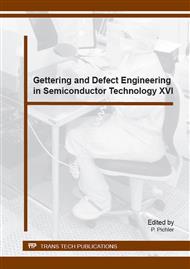[1]
F.D. Auret, S.M.M. Coelho, J.M. Nel, W.E. Meyer, Electrical characterization of defects introduced in n-Si during electron beam deposition of Pt, physica status solidi (a), 209 (2012) 1926-(1933).
DOI: 10.1002/pssa.201200578
Google Scholar
[2]
S.M.M. Coelho, F.D. Auret, P.J. Janse van Rensburg, J.M. Nel, Electrical characterization of defects introduced in n-Ge during electron beam deposition or exposure, Journal of Applied Physics, 114 (2013) 1737081-1737088.
DOI: 10.1063/1.4828999
Google Scholar
[3]
F.D. Auret, P.M. Mooney, Deep levels introduced during electron‐beam deposition of metals on n‐type silicon, Journal of Applied Physics, 55 (1984) 988-993.
DOI: 10.1063/1.333155
Google Scholar
[4]
G. Myburg, F. Auret, Influence of the electron beam evaporation rate of Pt and the semiconductor carrier density on the characteristics of Pt/n‐GaAs Schottky contacts, Journal of applied physics, 71 (1992) 6172-6176.
DOI: 10.1063/1.350426
Google Scholar
[5]
L.M. Tolbert, B. Ozpineci, S.K. Islam, M.S. Chinthavali, Wide bandgap semiconductors for utility applications, Power and Energy Systems, Proceedings, 1 (2003) 317-321.
Google Scholar
[6]
M. Siad, M. Abdesslam, A.C. Chami, Role of carbon in the formation of ohmic contact in Ni/4HSiC and Ni/Ti/4HSiC, Applied Surface Science, 258 (2012) 6819-6822.
DOI: 10.1016/j.apsusc.2012.03.108
Google Scholar
[7]
R. Madar, Materials science: Silicon carbide in contention, Nature, 430 (2004) 974-975.
DOI: 10.1038/430974a
Google Scholar
[8]
S. Yamada, B. -S. Song, T. Asano, S. Noda, Silicon carbide-based photonic crystal nanocavities for ultra-broadband operation from infrared to visible wavelengths, Applied Physics Letters, 99 (2011) 2011021-2011023.
DOI: 10.1063/1.3647979
Google Scholar
[9]
E. Omotoso, W.E. Meyer, F.D. Auret, A.T. Paradzah, M. Diale, S.M.M. Coelho, P.J. Janse van Rensburg, The influence of high energy electron irradiation on the Schottky barrier height and the Richardson constant of Ni/4H-SiC Schottky diodes, Materials Science in Semiconductor Processing, 39 (2015).
DOI: 10.1016/j.mssp.2015.04.031
Google Scholar
[10]
T. Marinova, A. Kakanakova-Georgieva, V. Krastev, R. Kakanakov, M. Neshev, L. Kassamakova, O. Noblanc, C. Arnodo, S. Cassette, C. Brylinski, B. Pecz, G. Radnoczi, G. Vincze, Nickel based ohmic contacts on SiC, Materials Science and Engineering: B, 46 (1997).
DOI: 10.1016/s0921-5107(96)01981-2
Google Scholar
[11]
F. Auret, S. Goodman, G. Myburg, W. Meyer, Electrical characterization of defects introduced in n-GaAs by alpha and beta irradiation from radionuclides, Appl. Phys. A, 56 (1993) 547-553.
DOI: 10.1007/bf00331403
Google Scholar
[12]
T. Kimoto, A. Itoh, H. Matsunami, S. Sridhara, L. Clemen, R. Devaty, W. Choyke, T. Dalibor, C. Peppermüller, G. Pensl, Nitrogen donors and deep levels in high‐quality 4H–SiC epilayers grown by chemical vapor deposition, Applied physics letters, 67 (1995).
DOI: 10.1063/1.114800
Google Scholar
[13]
A.A. Lebedev, Deep level centers in silicon carbide: A review, Semiconductors, 33 (1999) 107-130.
DOI: 10.1134/1.1187657
Google Scholar
[14]
T. Dalibor, G. Pensl, H. Matsunami, T. Kimoto, W.J. Choyke, A. Schöner, N. Nordell, Deep Defect Centers in Silicon Carbide Monitored with Deep Level Transient Spectroscopy, physica status solidi (a), 162 (1997) 199-225.
DOI: 10.1002/1521-396x(199707)162:1<199::aid-pssa199>3.0.co;2-0
Google Scholar
[15]
I. Pintilie, L. Pintilie, K. Irmscher, B. Thomas, Formation of the Z1, 2 deep-level defects in 4H-SiC epitaxial layers: Evidence for nitrogen participation, Applied Physics Letters, 81 (2002) 4841-4843.
DOI: 10.1063/1.1529314
Google Scholar
[16]
J. Doyle, M.K. Linnarsson, P. Pellegrino, N. Keskitalo, B. Svensson, A. Schoner, N. Nordell, J. Lindstrom, Electrically active point defects in n-type 4H–SiC, Journal of applied physics, 84 (1998) 1354-1357.
DOI: 10.1063/1.368247
Google Scholar
[17]
G. Pensl, W.J. Choyke, Electrical and optical characterization of SiC, Physica B: Condensed Matter, 185 (1993) 264-283.
DOI: 10.1016/0921-4526(93)90249-6
Google Scholar
[18]
L. Storasta, J.P. Bergman, E. Janzén, A. Henry, J. Lu, Deep levels created by low energy electron irradiation in 4H-SiC, Journal of Applied Physics, 96 (2004) 4909-4915.
DOI: 10.1063/1.1778819
Google Scholar
[19]
F. Nava, G. Bertuccio, A. Cavallini, E. Vittone, Silicon carbide and its use as a radiation detector material, Measurement Science and Technology, 19 (2008) 102001.
DOI: 10.1088/0957-0233/19/10/102001
Google Scholar
[20]
C. Hemmingsson, N.T. Son, O. Kordina, J.P. Bergman, E. Janzén, J.L. Lindström, S. Savage, N. Nordell, Deep level defects in electron-irradiated 4H SiC epitaxial layers, Journal of Applied Physics, 81 (1997) 6155-6159.
DOI: 10.1063/1.364397
Google Scholar
[21]
T.A.G. Eberlein, R. Jones, P.R. Briddon, Z1/Z2 Defects in 4H−SiC, Physical Review Letters, 90 (2003) 2255021-2255024.
Google Scholar


